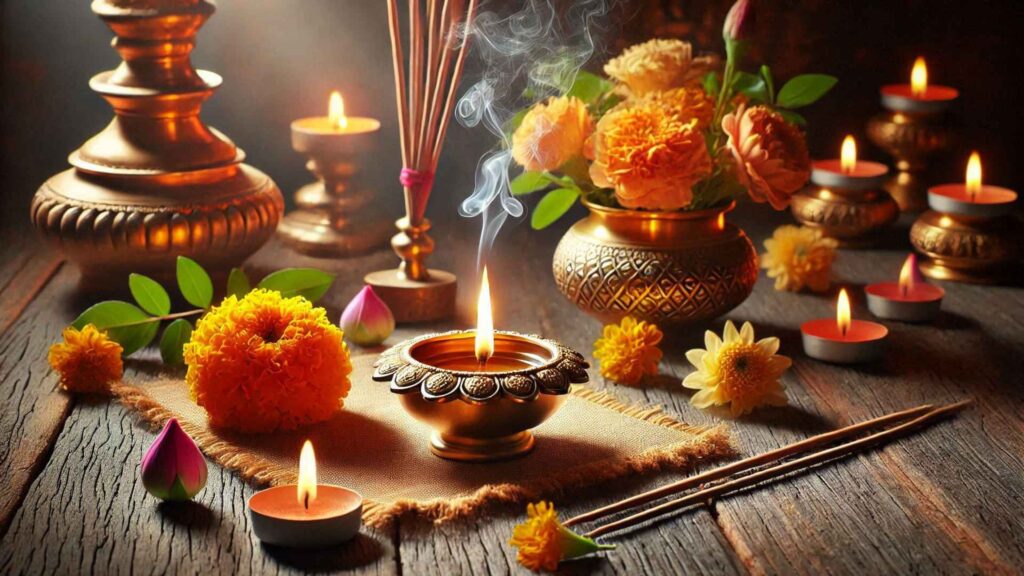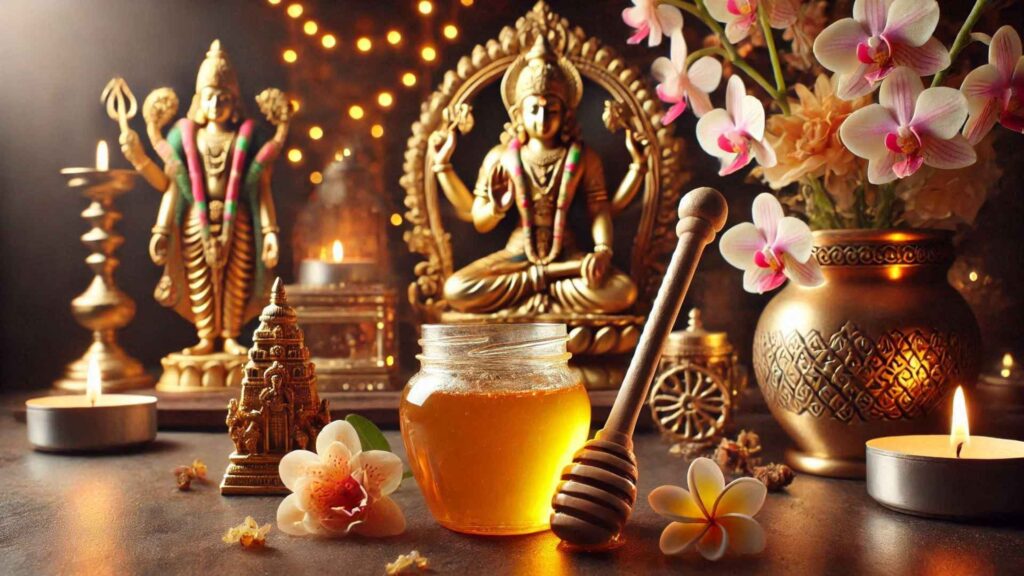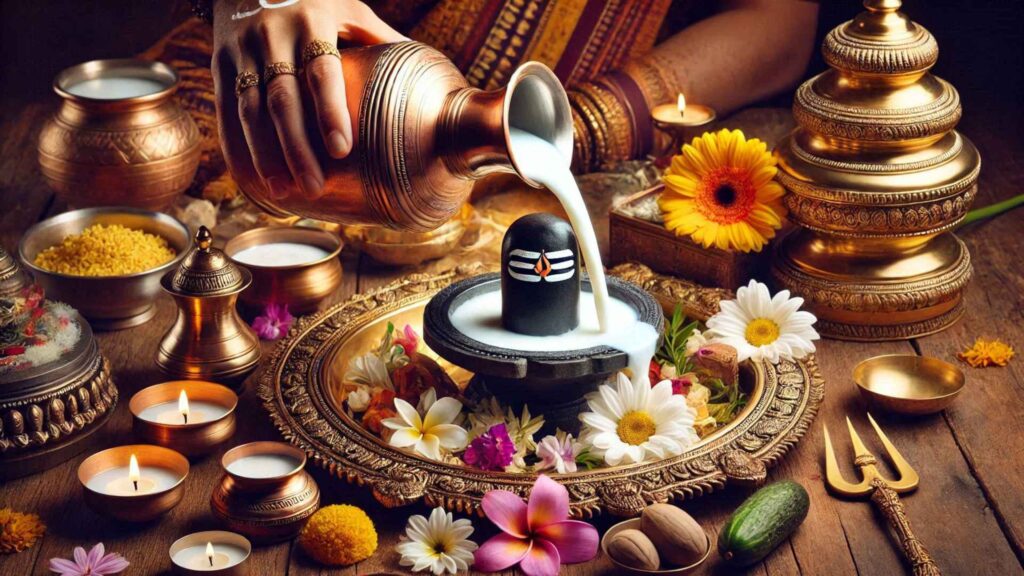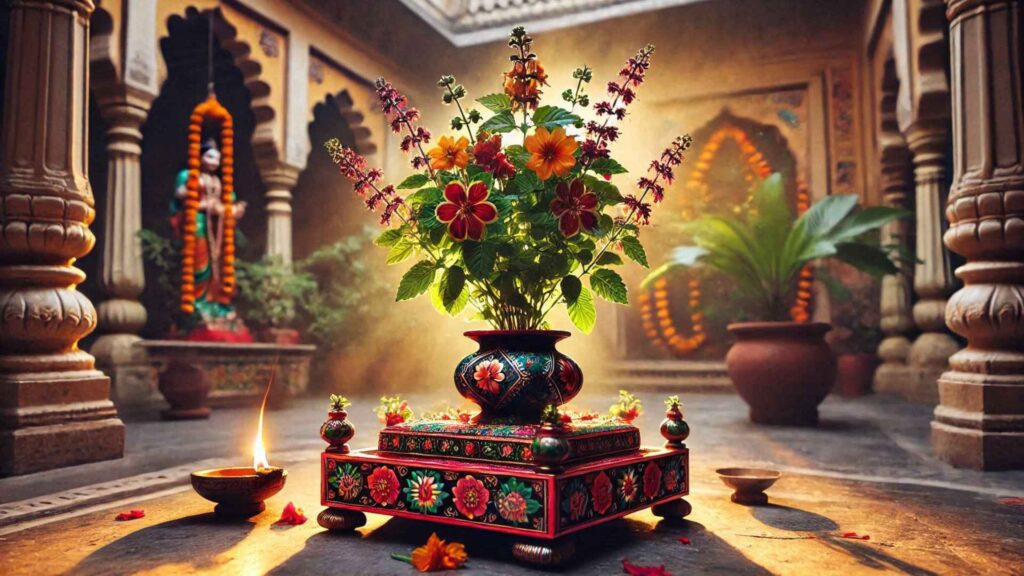Sacred Elements in Hindu Worship: Ghee, Honey, Milk, Tulsi Leaves, and Gangajal
The Concept of Sacredness in Hinduism
Hinduism, one of the oldest religions in the world, thrives on the concept of sacredness, which bridges the material and spiritual realms. At the core of Hindu rituals and worship are natural elements such as ghee, honey, milk and dairy products, tulsi leaves, and sacred water (Gangajal). These elements are not merely objects of offering but profound symbols of purity, nourishment, and divine connection.
Read More About sacred texts
Hook Statement
Picture the warmth of a ghee diya illuminating an altar, the sweetness of honey symbolizing divine grace, or tulsi leaves placed carefully as an offering. These elements transcend their material form, becoming sacred conduits of devotion and spirituality.
Overview of Sacred Elements
Each of these elements holds a deep spiritual and symbolic meaning. They are used in pujas (worship ceremonies), yajnas (fire rituals), and abhishekam (ritual bathing) to invoke blessings and establish a connection with the divine. Their sanctity lies in their ability to represent life’s essentials: nourishment, purity, and spiritual growth.
Modern Relevance
Even in today’s fast-paced world, these elements retain their importance, offering spiritual solace and grounding. They symbolize humanity’s respect for nature and its gifts, bridging ancient wisdom with contemporary practices.
2. Historical Background: Roots of Sacred Elements
Ghee

Ghee has been central to Hindu rituals since Vedic times. The Rigveda refers to ghee as an essential offering in fire rituals dedicated to Agni (fire god), symbolizing purity and transformation. Mythologically, ghee is linked to the Samudra Manthan (cosmic churning), where it emerged as a divine product.
Honey

Known as Madhu, honey is described in the Atharvaveda as a sacred substance with healing properties. It was historically used in offerings to deities to invoke sweetness, harmony, and prosperity. Over time, honey became a key component in panchamrit, the sacred mixture offered to gods.
Milk and Dairy Products

Milk, often referred to as the “elixir of life,” has been revered in Hinduism for its nourishing qualities. Associated with Kamadhenu, the divine cow, milk and its derivatives like butter and curd were used in rituals to symbolize purity and abundance. Texts like the Bhagavata Purana narrate Lord Krishna’s playful association with dairy products, solidifying their spiritual significance.
Tulsi Leaves

Tulsi, or holy basil, is regarded as a sacred plant and a manifestation of Goddess Lakshmi. The Padma Purana and Skanda Purana extol its significance, particularly in Vishnu worship. Tulsi’s introduction into Hindu rituals dates back to the Vedic period, symbolizing devotion and spiritual resilience.
Sacred Water (Gangajal)

Gangajal, the water from the Ganga River, is considered the holiest of all waters in Hinduism. Ancient scriptures like the Mahabharata and Ramayana describe its divine descent to Earth through King Bhagiratha’s efforts, symbolizing purification and liberation.
3. Spiritual Significance: Divine Connections of Sacred Elements
Ghee
Ghee represents purity, selflessness, and transformation. It is believed to enhance the sanctity of yajnas, acting as a bridge between the material and spiritual realms. The flame of a ghee diya is considered a representation of the eternal soul and divine light.
Honey
Honey symbolizes the sweetness of life and divine blessings. Its presence in panchamrit represents unity, harmony, and prosperity. Honey also reflects the interconnectedness of nature, as it is produced through collective effort.
Milk and Dairy Products
Milk symbolizes nourishment, purity, and abundance. In Hindu rituals, it is used to bathe deities during abhishekam, signifying spiritual cleansing and divine grace. Dairy products like butter and curd reflect prosperity and are often distributed as prasad to devotees.
Tulsi Leaves
Tulsi is a symbol of devotion, purity, and spiritual strength. It is believed to purify the environment and the soul. Tulsi leaves are indispensable in Vishnu worship, symbolizing the surrender of ego and alignment with divine will.
Sacred Water (Gangajal)
Gangajal is revered as the ultimate purifier, capable of cleansing sins and aiding in spiritual liberation. It is used in rituals to sanctify spaces, individuals, and objects, embodying the cyclical nature of life and rebirth.
4. Practical Application: Integration in Worship
Ghee
- Lighting Lamps: Ghee diyas are lit during daily prayers and festivals like Diwali, symbolizing the triumph of light over darkness.
- Yajnas: Ghee is offered into sacrificial fires to invoke divine blessings.
Honey
- Panchamrit Preparation: Honey is mixed with milk, curd, ghee, and sugar to create a sacred offering.
- Temple Rituals: Honey is used to anoint idols during special ceremonies, symbolizing sweetness and prosperity.
Milk and Dairy Products
- Abhishekam: Milk and curd are poured over idols during purification rituals.
- Prasad Distribution: Dairy-based sweets like butter and kheer are offered to deities and distributed as blessings.
Tulsi Leaves
- Daily Offerings: Tulsi leaves are placed on Vishnu idols as a mark of devotion.
- Household Rituals: Tulsi plants are worshipped daily, often serving as a focal point of spirituality in Hindu homes.
Sacred Water (Gangajal)
- Purification: Gangajal is sprinkled during rituals to cleanse and sanctify spaces.
- Life Events: It is used in rites like weddings, births, and funerals, symbolizing purity and divine connection.
5. Cultural Impact: Influence of Sacred Elements
Ghee
Ghee is a symbol of prosperity in Hindu households, prominently featured in festivals like Diwali. It is also a vital ingredient in traditional Indian cuisine and Ayurvedic practices.
Honey
Honey is celebrated for its health benefits and spiritual significance. Festivals like Madhu Purnima honor its role as a symbol of sweetness and abundance.
Milk and Dairy Products
Dairy products are central to festivals like Janmashtami, where Krishna’s love for butter is celebrated. Milk also holds a prominent place in Indian art and literature, often symbolizing fertility and abundance.
Tulsi Leaves
Tulsi is deeply ingrained in Hindu culture, celebrated during Tulsi Vivah, a symbolic marriage ceremony with Lord Vishnu. It remains a symbol of sanctity in Indian households.
Sacred Water (Gangajal)
Gangajal’s cultural significance extends beyond rituals, inspiring movements for river conservation and purification. It is central to events like the Kumbh Mela, the world’s largest religious gathering.
6. Conservation and Preservation
Challenges
- Pollution affecting the purity of Gangajal.
- Overharvesting of Tulsi plants and unsustainable dairy practices.
Preservation Efforts
- Initiatives like Namami Gange aim to clean and protect the Ganga River.
- Community-driven efforts promote organic farming for Tulsi and sustainable ghee production.
Future Outlook
With increased awareness, these sacred elements can be preserved through sustainable practices, ensuring their relevance for future generations.
7. Expert Insights
- Religious Scholars: “Sacred elements like ghee, honey, and Gangajal are the essence of Hindu rituals, connecting devotees to the divine.”
- Scientific Research: Studies validate the health benefits of honey, Tulsi, and ghee, aligning ancient traditions with modern science.
- Modern Interpretations: These elements are increasingly seen as symbols of sustainable living and holistic well-being.
8. Conclusion
The sacred elements of Hindu worship—ghee, honey, milk, tulsi leaves, and Gangajal—are timeless symbols of purity, devotion, and spiritual connection. They transcend rituals, embodying values that inspire reverence for nature and the divine.
Which sacred element resonates most with your spiritual practice? Share your thoughts and explore more on Hinduvism.com.


